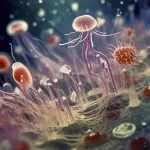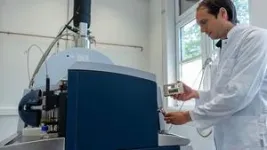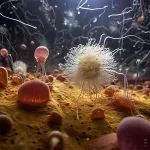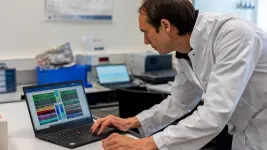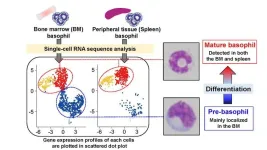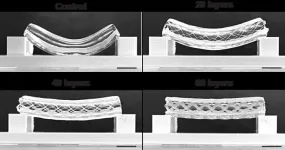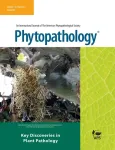(Press-News.org) Newly discovered biomarker signatures point to a whole range of previously unknown organisms that dominated complex life on Earth about a billion years ago. They differed from complex eukaryotic life as we know it, such as animals, plants and algae in their cell structure and likely metabolism, which was adapted to a world that had far less oxygen in the atmosphere than today. An international team of researchers, including GFZ geochemist Christian Hallmann, now reports on this breakthrough for the field of evolutionary geobiology in the journal Nature.
The previously unknown “protosteroids” were shown to be surprisingly abundant throughout Earth´s Middle Ages. The primordial molecules were produced at an earlier stage of eukaryotic complexity — extending the current record of fossil steroids beyond 800 and up to 1,600 million years ago. Eukaryotes is the term for a kingdom of life including all animals, plants and algae and set apart from bacteria by having a complex cell structure that includes a nucleus, as well as a more complex molecular machinery. “The highlight of this finding is not just the extension of the current molecular record of eukaryotes,” Hallmann says: “Given that the last common ancestor of all modern eukaryotes, including us humans, was likely capable of producing ‘regular’ modern sterols, chances are high that the eukaryotes responsible for these rare signatures belonged to the stem of the phylogenetic tree”.
Unprecedented glimpse of a lost world
This “stem” represents the common ancestral lineage that was a precursor to all still living branches of eukaryotes. Its representatives are long extinct, yet details of their nature may shed more light on the conditions surrounding the evolution of complex life. Although more research is needed to evaluate what percentage of protosteroids may have had a rare bacterial source, the discovery of these new molecules not only reconciles the geological record of traditional fossils with that of fossil lipid molecules, but yields a rare and unprecedented glimpse of a lost world of ancient life. The competitive demise of stem group eukaryotes, marked by the first appearance of modern fossil steroids some 800 Million years ago, may reflect one of the most incisive events in the evolution of increasingly complex life.
"Almost all eukaryotes biosynthesise steroids, such as cholesterol that is produced by humans and most other animals” adds Benjamin Nettersheim from the University of Bremen, first author of the study—“due to potentially adverse health effects of elevated cholesterol levels in humans, cholesterol doesn’t have the best reputation from a medical perspective. However, these lipid molecules are integral parts of eukaryotic cell membranes where they aid in a variety of physiological functions. By searching for fossilised steroids in ancient rocks, we can trace the evolution of increasingly complex life”.
What the Nobel laureate thaught impossible...
Nobel laureate Konrad Bloch had already speculated about such a biomarker in an essay almost 30 years ago. Bloch suggested that short-lived intermediates in the modern biosynthesis of steroids may not always have been intermediates. He believed that lipid biosynthesis evolved in parallel with changing environmental conditions throughout Earth history. In contrast to Bloch, who did not believe that these ancient intermediates could ever be found, Nettersheim started searching for protosteroids in ancient rocks that were deposited at a time when those intermediates could actually have been the final product.
But how to find such molecules in ancient rocks? “We employed a combination of techniques to first convert various modern steroids to their fossilised equivalent; otherwise we wouldn’t have even known what to look for,” says Jochen Brocks, professor at the Australian National University who shares the first-authorship of the new study with Nettersheim. Scientists had overlooked these molecules for decades because they do not conform to typical molecular search images. “Once we knew our target, we discovered that dozens of other rocks, taken from billion-year-old waterways across the world, were oozing with similar fossil molecules.”
The oldest samples with the biomarker are from the Barney Creek Formation in Australia and are 1.64 billion years old. The rock record of the next 800 Million years only yields fossil molecules of primordial eukaryotes before molecular signatures of modern eukaryotes first appear in the Tonian period. According to Nettersheim “the Tonian Transformation emerges as one of the most profound ecological turning points in our planet’s history“. Hallmann adds that “both primordial stem groups and modern eukaryotic representatives such as red algae may have lived side by side for many hundreds of millions of years”. During this time, however, the Earth's atmosphere became increasingly enriched with oxygen — a metabolic product of cyanobacteria and of the first eukaryotic algae that would have been toxic to many other organisms. Later, global "Snowball Earth” glaciations occurred and the protosterol communities largely died out. The last common ancestor of all living eukaryotes may have lived 1.2 to 1.8 billion years ago. Its descendants were likely better able to survive heat and cold as well as UV radiation and displaced their primordial relatives.
Since all stem group eukaryotes are long extinct, we will never know for certain how most of our early relatives looked like, but artistic efforts have created tentative visualisations (see pictures attached), while the primordial steroids may eventually shed more light on their biochemistry and lifestyle. “Earth was a microbial world for much of its history and left few traces.” Nettersheim concludes. Research at ANU, MARUM and GFZ continues to pursue tracing the roots of our existence — the discovery of protosterols now brings us one step closer to understanding how our earliest ancestors lived and evolved.
END
Remains of an extinct world of organisms discovered
Until now, certain biomarkers, the "protosteroids," have been overlooked as fossil witnesses to primordial life.
2023-06-07
ELSE PRESS RELEASES FROM THIS DATE:
Scientists discover ‘lost world’ of our early ancestors in billion-year-old rocks
2023-06-07
The newly discovered record of so-called protosteroids was shown to be surprisingly abundant throughout Earth´s Middle Ages. The primordial molecules were produced at an earlier stage of eukaryotic complexity – extending the current record of fossil steroids beyond 800 and up to 1600 million years ago. Eukaryotes is the term for a kingdom of life including all animals, plants and algae and set apart from bacteria by having a complex cell structure that includes a nucleus, as well as a more complex molecular machinery. “The highlight of ...
ChatGPT designs its first robot with TU Delft researchers
2023-06-07
Poems, essays and even books – is there anything the open AI platform ChatGPT can’t handle? These new AI developments have inspired researchers at TU Delft and the Swiss technical university EPFL to dig a little deeper: For instance, can ChatGPT also design a robot? And is this a good thing for the design process, or are there risks? The researchers published their findings in Nature Machine Intelligence.
What are the greatest future challenges for humanity? This was the first question that Cosimo Della Santina, assistant professor, and PhD student Francesco Stella, both from TU Delft, and Josie Hughes from EPFL, asked ...
New study could help unlock ‘game-changing’ batteries for electric vehicles and aviation
2023-06-07
Study led by University of Oxford researchers has revealed the mechanisms that cause lithium metal solid-state batteries to fail.
Researchers used a high-resolution imaging method to visualize batteries in unprecedented detail during charging.
The new insights could help overcome the technical issues with solid-state batteries, unlocking a game-changing technology for electric vehicles and aviation.
Significantly improved electric vehicle (EV) batteries could be a step closer thanks to a new study led by University of Oxford researchers, published today in Nature. ...
New study identifies mechanism driving the sun’s fast wind
2023-06-07
The fastest winds ever recorded on Earth reached more than 200 miles per hour, but even those gusts pale in comparison to the sun’s wind.
In a paper published June 7, 2023 in the journal Nature, a team of researchers used data from NASA’s Parker Solar Probe to explain how the solar wind is capable of surpassing speeds of 1 million miles per hour. They discovered that the energy released from the magnetic field near the sun’s surface is powerful enough to drive the fast solar wind, which is made up of ...
Pre-basophils: A basophil origin story
2023-06-07
Researchers from Tokyo Medical and Dental University (TMDU) find that pre-basophil and mast cell progenitors differentiate into pre-basophils before producing mature basophils in mice
Tokyo, Japan – Big changes often happen in small steps, and it’s not always easy to see how we get from point A to point B. Now, researchers from Japan have found a new step in the process of cell differentiation that leads to the production of fully functional basophils, which are critical cells in the immune system.
In a study published this month in Nature Communications, researchers from Tokyo Medical and Dental University (TMDU) have revealed a previously unknown intermediate ...
Study uncovers role of ultraviolet radiation in development of rare leukemia in the skin
2023-06-07
BOSTON – A change of scenery can restore one's outlook, but for some precancerous cells, a journey from the caves of the bone marrow to the sunny climes of the skin can trigger genetic changes that are a harbinger of cancer, according to a new study by researchers at Dana-Farber Cancer Institute, Brigham and Women's Hospital, and the Broad Institute of MIT and Harvard.
The study, published online today by the journal Nature, is one of the first to uncover the "genetic travelogue" ...
Evaluating AI responses to public health questions
2023-06-07
About The Study: This analysis of the quality of responses to public health questions found that ChatGPT consistently provided evidence-based answers, although it primarily offered advice rather than referrals. Given the same addiction questions, Amazon Alexa, Apple Siri, Google Assistant, Microsoft’s Cortana, and Samsung’s Bixby collectively recognized 5% of the questions and made one referral, compared with 91% recognition and two referrals with ChatGPT.
Authors: John W. Ayers, Ph.D., M.A., of the University of California San Diego in La Jolla, is the corresponding author.
To ...
NCCN releases statement addressing ongoing chemotherapy shortages; Shares survey results finding more than 90% of cancer centers are impacted
2023-06-07
PLYMOUTH MEETING, PA [June 7, 2023] — The National Comprehensive Cancer Network® (NCCN®)—an alliance of leading academic cancer centers—published survey results today that shed light on just how widespread the current platinum chemotherapy shortage is, and shared a statement calling on the whole oncology community to work together on solutions.
“This is an unacceptable situation. We are hearing from oncologists and pharmacists across the country who have to scramble to find appropriate alternatives for treating their patients with ...
Combining bioprinting techniques to pursue functional blood vessels
2023-06-07
In this project volumetric bioprinting was for the first time successfully combined with melt electrowriting. This combines the speed and cell-friendliness of volumetric printing with the structural strength needed to create functional blood vessels. The study by the biofabrication lab of Regenerative Medicine Center Utrecht (RMCU) was published today in Advanced Materials.
Volumetric printing is a technique that was pioneered for bioprinting by the RMCU biofabrication lab in 2019. It is a fast technique, which allows cells to survive the printing process. However, because this ...
Leading plant science journal publishes a special issue on key discoveries in plant pathology
2023-06-07
In just 7 years, the Irish Potato Famine caused approximately one million people to starve to death and forced another estimated million to flee Ireland as refugees. A mold called Phytophthora infestans infected Ireland’s potato crop, a staple food, and spread rapidly throughout the island. The seemingly tiny fungus destroyed roughly 75% of potato crops over the duration of the great hunger. This catastrophic famine, along with several others in various parts of the world throughout history, highlighted the critical need for the study of plant diseases.
Decades ...
LAST 30 PRESS RELEASES:
Structural findings reveal how distinct GPCR ligands create different levels of activation
Anything-goes “anyons” may be at the root of surprising quantum experiments
UC review: Maximizing workplace opportunity for veterans
From generation to complex control: Metasurfaces make perfect vortex beams "within reach"
Thin-film lithium niobate-based detector: recent advances and perspectives
Exploring why some people may tend to persistently make bad choices
How cells balance their protein levels
Nirsevimab vs RSVpreF vaccine for RSV–related hospitalization in newborns
Effectiveness and impact of maternal RSV immunization and nirsevimab on medically attended RSV in US children
AI gives scientists a boost, but at the cost of too many mediocre papers
Next-generation vision model maps tree growth at sub-meter precision
Genes aren’t destiny for inherited blindness, study shows
MIT study: High-fat diets make liver cells more likely to become cancerous
Exposure to multiple fine particulate matter components and incident depression in the US Medicare population
Risk of burdensome health care spending over time in the US
Nirsevimab against hospitalizations and emergency department visits for lower respiratory tract infection in infants
New microfluidics technology enables highly uniform DNA condensate formation
A new strategy for immune tolerance
Super Mario Bros. help fight burnout: New study links classic games to boosted happiness
Deepest gas hydrate cold seep ever discovered in the arctic: International research team unveils Freya Hydrate Mounds at 3,640 m depth.
Integrating light and structure: Smarter mapping for fragile wetland ecosystems
ACA-SIM: A robust way to decode satellite signals over complex waters
Probiotics can restore gut microbiome in breastfed infants
AI could help predict nutrition risks in ICU patients, study finds
Federal EITC has unexpected result, researchers say – it decreases domestic violence
Researchers identify gene that calms the mind and improves attention in mice
Artificial metabolism turns waste CO2 into useful chemicals
Ancient sea anemone sheds light on animal cell type evolution
Begging gene leads to drone food
How climate policies that incentivize and penalize can drive the clean energy transition
[Press-News.org] Remains of an extinct world of organisms discoveredUntil now, certain biomarkers, the "protosteroids," have been overlooked as fossil witnesses to primordial life.
